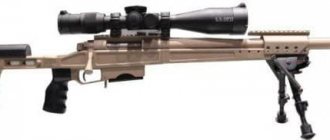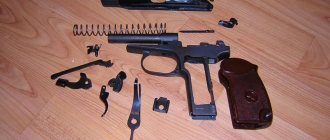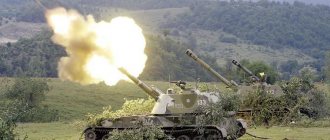Muzzle-loading weapons in modern Russia: from a musket - shoot!
...The air smelled sharply of burnt gunpowder. His hands deftly hammered a heavy ball of lead bullet into the barrel with a ramrod. Then the shooter raised his weapon, long as an oar, to his shoulder. The dog, cocked all the way, clicked. The front sight found its target. Shot! In a closed room, its sound hit my ears like a hammer. The shooter was covered in a dense veil of smoke. Target? A hole appeared in it, into which the index finger could easily fit. “They can’t survive with such a wound!” - the shooter explained. And, satisfied, he began to clean the barrel of his French musket...
No, this was not a scene from a historical novel or film. This is a true description of what can sometimes be seen in today's Russian shooting ranges and shooting ranges.
Everything is fair
Squeaks, arquebuses, muskets, flintlock pistols. These words leave a leaden taste in your mouth, and the shadows of conquistadors, pirates, musketeers, grenadiers and other duelists begin to wander in the back of your mind. Shadows that have long sunk into oblivion.
It is all the more surprising to discover people who, in our 21st century and in our country, want to literally feel like former adventurers and warriors. People who take real weapons into their hands to do this. Historical weapons. Muzzle-loading.
Everything is fair. No modern polymers, automatic fire mode, collimators, magazines, unitary cartridges or unloading vests. Copper, brass, walnut stock, primitive front sight, long ramrod, bullet gun, powder flask, wad, flint, black powder. And the weight is under 5 kg. For comparison, the weight without a magazine of the AK74M assault rifle currently in service is 3.40 kg.
Can anyone really like to tinker with a bullet gun and a powder flask in the era of high-tech? It turns out - yes!
Weapons as art
To find out the answer to this phenomenon, we go to visit Andrei Shelegov , chairman of the Russian branch of the Association of Muzzle-loading Weapon Shooters. We enter, say hello, and ask the first of dozens of accumulated questions:
— Why do people still have a craving for muzzle-loading weapons?
Andrei answers immediately - it’s clear that he is accustomed to this question:
“The state, which wants to instill in citizens knowledge of its history and respect for it, supports any undertakings that allow a more in-depth and detailed study of certain historical events. And citizens themselves, encountering the heritage of the past in everyday life, sooner or later begin to become interested in objects of material culture corresponding to a certain era. For some these are coins, for others - paintings... Weapons are also one of the most significant witnesses of the past. With weapons, man conquered countries and continents, discovered new lands, obtained food and defended himself from enemies. A significant role in shaping the desire to own weapons, including muzzle-loading ones, belongs to “the most important of the arts” - cinema. And literature did not stand aside. The heroes of Dumas, Verne, Stevenson wielded weapons as an extension of their hands. Which boy didn't want to be just like them? But men, as you know, always remain boys inside... That is, there is quite a demand for historical weapons. And if there is demand, there is supply. And on the shelves, first in America and Europe, and then here, samples of historical weapons appeared for reenactors, shooters, and collectors.
— What prompted you personally to the idea of purchasing such a weapon?
— I was born into a military family, I read a lot of historical and adventure literature. He received his education as a history teacher. I have owned civilian weapons since 1993. All this in a complex, probably. Muzzle-loading weapons are a very interesting and multifaceted subject for study and aesthetic pleasure. Some people get pleasure from admiring an ancient Greek statue, others - from looking at the filigree treatment of a gun barrel. Both the first and second are art.
The horror and grace of a musket
Well, let's touch on art. We pick up a replica, that is, a modern exact copy of a French musket. The weight, appearance, and usability of the weapon inspire respect. And the real bayonet, leather belt and a whole bunch of surrounding accessories, such as a bag of bullets and powder powder, attached to the musket give the weapon an indescribable charm. This is truly a piece of art...
The musket lead bullet, weighing 23.0 g and caliber 17.5 mm, is no less shocking than the weapon itself. These are not modern high-velocity conical bullets of 5.45 and 7.63 mm calibers, which can pierce right through a person without any problems. When a musket “testicle” hits a body, it will instantly flatten from impact into a “pancake” one and a half times larger in diameter than the original caliber of the bullet.
Can you imagine what such a hit will do to the body? What will remain of the muscles, blood vessels and bones? But there are also pieces of clothing that the bullet will “grab” into the wound. Let’s add here the general unsanitary conditions that reign on the battlefield, the low level of field medicine of the past and... Yes - “they can’t survive with such a wound.” But that's not all the musket is capable of. Let's not forget the sting of the bayonet and the metal-bound butt, which can easily crack any skull like a nut shell.
Hmm... Terrible weapon. Scary. But - elegant and surprisingly harmonious.
Manufacturer, price and sellers
— Andrey, tell us about the sample of muzzle-loading weapon you have. Why did you choose it?
— I am the owner of a copy of the French dragoon musket An IX model 1777, manufactured by the Italian company Davide Pedersoli. This is a very interesting muzzle-loading smoothbore weapon. Interesting both in terms of its design and design. Durable, technologically advanced, reliable, powerful gun with a long history. It was with this weapon that Napoleon’s troops crossed the border of our Motherland... In addition, the gun is simply beautiful, as it contains brass parts, copies of the marks of the arsenal in Saint-Etienne. The musket stock is made of magnificent walnut. As for the choice... In fact, it was determined not so much by the desire to hold a Napoleonic musket in one’s hands, but by its availability on the market and price at the time of purchase in 2010.
“Then let’s take our conversation to a practical level.” How, where and at what price can a person in Russia now purchase such weapons? What documents will he need for this? What consumables and equipment does the owner of a muzzle-loading weapon need? Where and at what price can all this be purchased from us?
— Currently, you can purchase muzzle-loading weapons in a number of gun stores. These are Italian and Indian-made weapons. Italian has both certificates for hunting weapons and weapons intended for cultural and educational purposes. Accordingly, you can buy it on the basis of a license to purchase smooth-bore or rifled hunting weapons. Rifled, in accordance with the Law “On Weapons”, only after 5 years of owning a smoothbore.
It turned out that in order to obtain the appropriate license, a citizen will need to contact the internal affairs authorities at the place of registration and provide the necessary list of documents. To purchase weapons intended for use for cultural and educational purposes, a license is not required; the necessary conditions are age from 18 years and citizenship of the Russian Federation.
The official representative of the Italian company Davide Pedersoli is the large Moscow store “Kolchuga”. The price for Italian samples ranges from 45 to 150 thousand rubles. Indian weapons can be ordered from Izhevsk. These are cheaper guns, certified as weapons used for cultural and educational purposes. They are not intended for hunting and are purchased primarily for historical reconstruction.
It turns out that all owners of such beauty should take into account that servicing a muzzle-loading weapon requires a significant number of devices and accessories. These are bullets, measures and containers for gunpowder - powder flasks, powder flasks. Cleaning rod with various attachments for loading, removing stuck bullets, wads and patches. Needle for cleaning the pilot hole. A key for fire tubes of primer samples or for clamping the trigger jaws in flintlock guns. It is desirable to have a starter to feed spherical bullets into the barrel. And other items that make it easier for the shooter to maintain the weapon and make its operation as safe as possible.
Bang Bang!
Natruski, needles... Sounds like the arsenal of an alchemist, not a shooter. But that only makes it more interesting. Andrey explains and shows how the musket is loaded. Oh, this is not an easy task! The weapon is placed at half cock. A thick needle is stuck into the ignition hole as both a fuse and a cleaning tool. Then black powder - 5 g - is poured into the barrel. Behind the gunpowder is a wad and a patch. A bullet is placed on top of everything and nailed tightly with a ramrod. We return to the pilot hole. We remove the needle and pour a little gunpowder next to the ignition hole. We close the shelf, cock the hammer with a clamped piece of flint for another “click”. That's it - you can shoot. We look at the clock. The loading process took one and a half minutes. But in the 18th century, an experienced soldier with a flintlock gun managed to fire 3 shots in a minute. Wow.
“That’s what experience and the desire to survive mean!” - Andrey comments on this moment.
We are aiming... Very unusual. Among the sighting devices, there is one front sight. Everything else is passive. However, what else can you expect from a smooth-bore gun designed to hit a large target like “a crowd in someone else’s uniform” with volley fire from fifty steps away? So, let's take aim... The barrel is long and heavy. Your hands begin to get tired - the front sight “walks” more and more actively just above the target. Carefully pull the trigger. Click! Misfire! This is a completely normal phenomenon for flints. There can be many reasons - the flint is chipped, the ignition hole is clogged, the barrel is poorly cleaned, the gunpowder is wet - remember the canonical “keep the gunpowder dry”?
We add gunpowder to the shelf, cock the hammer, aim again and... misfire again. And again and again. In a real battle, every misfire can result in the death of the shooter. In our case, a misfire only causes laughter.
“But our ancestors had no time for laughter,” notes Andrey. “Anything could happen in the heat of the battle.” For example, a soldier could load a weapon, pull the trigger, the gunpowder on the shelf would ignite, but due to a clogged ignition hole the shot would not fire. However, due to the roar of the battle and his own adrenaline, the soldier did not notice this.
- And what?
- And the fact that the soldier began to load his musket again. I pressed the trigger and again there was no shot: the ignition hole had not been cleaned. And the battle continues, the adrenaline is pumping! And our guy begins to load for the third time... This is how it turned out that on the fields of defunct battles they found guns with 3-6 bullets stuffed into them.
After a pause, Shelegov talks about how recruits in battle often forgot ramrods in the barrel of their weapons. During the subsequent shot, the ramrod flew away, leaving the klutz without any opportunity to load his musket again.
“This also happens now,” adds Andrey.
— At competitions?
- Not only. On October 2, 2011, in the Ukrainian Kamenets-Podolsk there was a festival of reenactors with muzzle-loading weapons. The participants, dressed as Cossacks and Streltsy, had to role-play a battle. Well, shoot at each other, putting gunpowder into the barrels, but not placing a bullet. Blank shooting, in short. During this performance, the Ukrainian forgot a cleaning rod in the barrel of his gun. After the shot, the ramrod hit 38-year-old Russian Sergei Udod directly in the head. The wound turned out to be fatal...
Finally our musket kicks with its butt in the shoulder and spews out a long torch of fire. Bang! Pow!
Yes, yes, a shot from a flintlock up close sounds exactly like a classic “bang-bang.” First, the “bang” is the ignition of the gunpowder on the shelf, and then the “bang” is the shot itself. Between the first and second, according to subjective sensations, at least a second passes. It is very difficult to get used to this style of shooting after practicing with modern firearms. After all, after pressing the trigger and a flash of flame on the shelf, you must continue to hold the almost five-kilogram “bar” aimed at the target until that cherished moment when the barrel gasps. Hold, despite the fact that all your reflexes persistently ring in your brain: since there was a flash, the shot ALREADY happened.
Yes, this is not an easy matter. Our first shot goes into the “milk”. Andrey laughs and says that it took him a long time to get used to such an unusual weapon. One day he was so desperate that, contrary to historicism, he even attached a laser designator to his musket! But then I gradually got used to hitting without it.
Shooting Association
— How great is the interest in muzzle-loading weapons in Russia? - we ask.
Shelegov first blows through the musket's flash hole and only then answers:
“Alas, it’s not as big as we would like it to be.” This kind of weapon appeared in our country relatively recently, is quite expensive, its scope is quite narrow, and its use requires special skills.
— You are a member of the Russian Association of Muzzle-loading Weapon Shooters. Tell us, what kind of organization is this?
— In English, it is briefly called MLARF — Muzzle Loaders Association of Russian Federation. The association emerged in December 2011 as an organization designed to unite all lovers of historical weapons. I would like to clarify: strictly speaking, the term “historical weapon” is not used anywhere, although it most accurately characterizes weapons that are technically outdated, but have not lost their attractiveness in the eyes of enthusiasts. These include muzzle-loading and breech-loading weapons, and much more. Our Association was created to unite everyone who likes once formidable weapons.
The organization finally has the opportunity to communicate, exchange information and experience, conduct practical classes and seminars, and participate in competitions, says Shelegov. The first regional representative offices of the Association were created in Moscow and St. Petersburg. “And it is currently headed by your humble servant,” adds Andrey.
— What do you need to join your Association and feel like a real... Well, let's say, a grenadier? Recommendation from some military history club?
— It’s enough just to contact us. The main requirements for candidates are knowledge and compliance with Russian legislation, the absence of contraindications for owning firearms and a willingness to participate in solving the problems facing our Association.
— Does the Russian Association of Muzzleloading Weapon Shooters maintain any contacts with similar foreign organizations?
- To the fullest. We are an active member of the Muzzleloading Associations International Committee (MLAIC). Representatives of our Association have been participating in the World and European Championships for several years.
And about sanctions
Finally, we ask whether the sanctions imposed by the West have created any difficulties for the acquisition of muzzle-loading weapons in Russia.
- Are we having difficulties? “I wouldn’t say that,” says Shelegov, simultaneously cocking the gun, which gives his words a purely cinematic ambiguity.
We laugh. After which Andrey explains:
“Even our foreign partners sensibly assess the low level of danger of muzzle-loading weapons and do not raise obstacles at the state level. This is what manufacturers of historical weapons actively use. One could even say that in terms of availability on the shelf and the size of the assortment, this year is very successful for us. A much bigger problem is the decrease in purchasing power due to the depreciation of the ruble against the European currency. Alas, the price of muzzle-loading weapons has almost doubled.
Without fear of misfires
And yet, what are the future prospects for the growth in the number of owners of muzzle-loading weapons in Russia. Will it be used exclusively for entertainment and sporting purposes, or can it also become a hunting weapon? In general, are there people in Russia now who go hunting with muskets?
“We hope that the number of people interested in historical weapons will increase,” Shelegov answers. “And we not only hope, but also contribute to this in every possible way.” Through competitions, through informing the target audience on social networks, through reenactment clubs and military-patriotic associations, through organizing a dialogue between manufacturers, legislators and trade organizations with citizens.
As for hunting, there are already shooters who use muzzle-loading weapons in this matter. With the impossibility of quick reloading, every precise shot turns into a true art. This is why this type of hunting is valued.
Finally, the prospect of using historical weapons in the patriotic education of youth is also important for the Association. After all, it’s one thing to look at a picture in a textbook. And it’s quite another thing to come to the competition and see in action the weapons that have protected our country for centuries.
— See, among other things, misfires?
- So this is also part of the story. Both ours and the world!..
Andrey Soyustov
When fired, the bullet moves inside the barrel. If you make a stretched screw thread in the barrel, then, moving in the barrel, the bullet will spin like a top. So, rotating, it will then fly, and the rotation will not allow it to tumble in the air. This increases the range and accuracy of fire. The first examples of small arms with screw rifling were created back in the 16th century (screw-mounted arquebus and rifled gun - fitting). However, weapons with rifling in barrels did not become widespread until the mid-19th century. First of all, it was difficult to manufacture. And then - and this is the most important thing - a lot of effort was required to drive the bullet tightly into the barrel. Nothing could be done with her with just a ramrod. I had to drive the bullet in by hitting the ramrod with a heavy wooden mallet. Naturally, there was no time for this fuss in battle. The bullet required two incompatible properties. The bullet should enter the barrel freely, with a gap, so that loading the gun is easy. The bullet must go back tightly, without a gap, so that the screw thread acts on it. This is a puzzling task. Inventors worked on its solution in many countries and at different times. They went different ways.French fitting
Russian Jaeger fitting, model 1778
WEAPONS AND PRODUCTION
The country's weak industrial base sometimes hindered the development of new types of weapons. A typical example in this regard is an attempt to arm the Russian army with a model of a serf gun developed and adopted in 1839, in the design of which all the new ideas of that time were used: loading from the treasury, a striker-fired mechanism and a rifled barrel. This gun never went into mass production, and only a smooth-bore, flintlock, muzzle-loading gun remained in service. The reason, unfortunately, is typical: Russian factories at that time were not prepared for the production of these guns, which required great precision in the manufacture of individual parts.
In 1826, the Frenchman Del Vigne made a chamber for a powder charge somewhat narrower than a gun channel, and sent bullets to it with a ramrod. However, this invention was not very successful and did not gain distribution. In 1844, the French artilleryman Tourven designed a new gun. It was still loaded from the muzzle, but a spike was placed at the bottom of the breech, onto which the bullet, lowered from the muzzle into the gun barrel, settled. The bullet was conical; when struck with a ramrod, it was pushed onto the rod, spread out wide and filled the rifling. Turven's rod system turned out to be durable and practical, and therefore the fitting of his design was adopted in France, Belgium, Prussia and other countries.
Russian infantry in the Caucasus (mid-19th century):
1 - chief officer; 2 - grenadier; 3 - huntsman; 4 - infantryman
Specially shaped bullets also appeared. For example, one of these tricky bullets was designed by the French captain Minier in 1848. The Minié bullet, as it was called, was oblong. There was a deep recess at the bottom into which an iron cup was inserted. The Minie bullet entered the barrel freely. But when fired, the powder gases drove the iron cup inside the bullet with great force, and this caused it to expand. Moving along the barrel, the bullet pressed tightly against the rifling and began to rotate quickly.
Cross section of the barrel of a Minie gun and its bullet
Russian troops became familiar with the Minié rifle bullet during the Crimean War. The opponents of the Russians were the British, armed with Enfield guns under Minie bullets, and the French, who had Turvain guns. In the Russian troops, the number of rifled guns was no more than 5 percent of the total number. While Russian bullets kicked up dust at a distance of three hundred paces from their lines, English and French bullets flew a thousand or more paces, inflicting heavy losses on the Russian troops.
Belgian (Lüttich) fitting (1843)
Russian six-line (15.24 mm) rifle
Towards the end of the Crimean War, the Russian government began to introduce into its troops rifled guns equipped with Minié bullets. In 1856, gunsmiths A.V. Lyadin, L.G. Rezvy, K.I. Konstantinov created a cap gun of a reduced caliber (up to 15.24 mm), which was approved for infantry use in the same year. It made it possible to conduct aimed fire at a distance of 853 meters—four times further than the old smooth-bore guns! The newly introduced rifled gun received a new name - rifle. It weighed 4.8 kilograms and had 4 grooves in the barrel. Since then, the term "rifle" has become firmly established in the military lexicon.
The Model 1856 rifle percussion rifle and its infantry, dragoon and Cossack models were the last domestic models of muzzle-loading weapons.


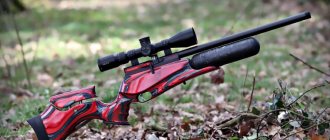
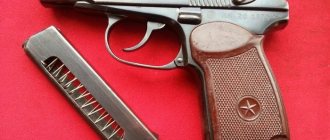
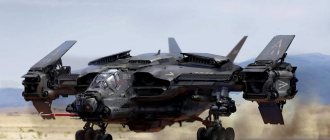
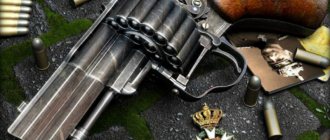
!['Domestic small arms [studio "Wings of Russia"] (2011)'](https://knifesburg.ru/wp-content/uploads/otechestvennoe-strelkovoe-oruzhie-studiya-krylya-rossii-2011-330x140.jpg)

